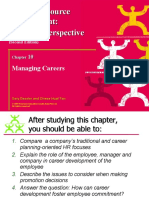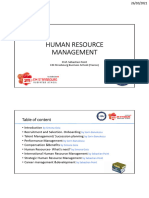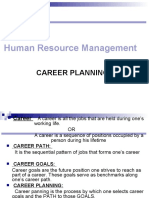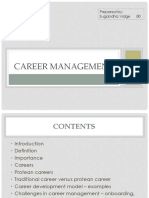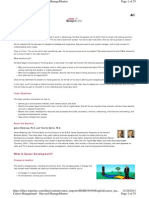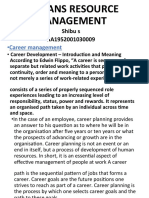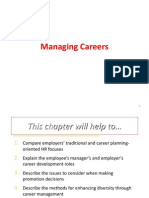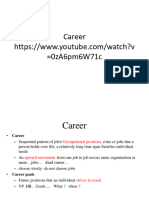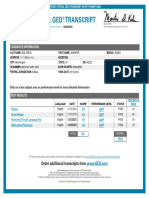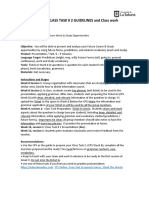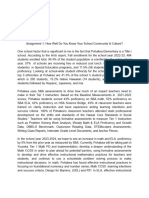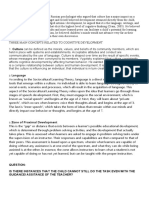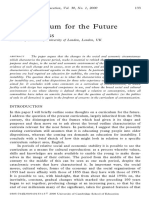Navigating Career Advancement: Challenges for Mid-Career Professionals
Name: Abhishek Kumar Shaw
University Roll: 30400924051
College Roll: 2281031
Subject: Human Resource Management
Paper Code: MB 206
Overview
Mid-career professionals often struggle to choose between job stability and career
progression. Anita Sharma and Rajiv Menon, both employees at Zenith Technology, are
facing such a dilemma. Zenith Technology is recognized for its innovation and employee-
friendly environment, but its slow promotion system presents challenges for career growth.
Anita, a 35-year-old senior marketing manager, has developed expertise in brand
management and digital marketing. However, she feels her career has reached a standstill.
She has received an offer from a Global Consumer Goods Company, which includes a 25%
salary increase and a leadership role. Although this offer is tempting, she is unsure about
adapting to a new corporate culture and leaving her current stable position. Her challenge is
to decide whether to accept the offer or negotiate for career growth within her current
company.
Rajiv, a 40-year-old product development lead, has been with Zenith Technology for 12
years but feels unfulfilled in his current role. He aspires to transition into a strategic role but
lacks formal training. His options include pursuing an Executive MBA, enrolling in short-
term certification programs, or developing strategic skills within his current role. However,
he is uncertain whether investing in additional education will guarantee his desired career
shift.
Both Anita and Rajiv need to evaluate their options by considering long-term career goals,
financial stability, and opportunities for skill enhancement.
Q1. Should Anita accept the job offer or negotiate with her current employer?
Anita must carefully assess her long-term career aspirations. While Zenith Technology
provides stability and a familiar work environment, its slow promotion system may hinder
her growth. If her employer can offer a clear leadership path and match the salary increase,
staying may be a viable option. However, if career progression remains limited, the external
offer presents an opportunity for immediate growth and financial benefits. She should also
�consider adaptability to a new corporate culture, job security, and long-term career
potential before making a final decision.
Q2. How should Rajiv approach his career transition—through an Executive
MBA, short-term certification, or internal skill development?
Rajiv has several options to enhance his strategic decision-making skills:
- Executive MBA: This offers structured learning, industry credibility, and networking
opportunities, but it requires a significant investment of time and money.
- Short-Term Certifications: These provide a cost-effective way to acquire knowledge in
strategic planning, leadership, and business management, though they may not be as widely
recognized as an MBA.
- Internal Skill Development: Engaging in cross-functional projects, seeking mentorship, and
participating in company training programs can help him transition into a strategic role
gradually.
Rajiv should assess his financial standing, personal commitments, and time availability
before deciding which option aligns best with his career goals.
Q3. What key factors should employees consider when making career transition
decisions?
Employees should take the following factors into account when making career transitions:
- Career Growth Potential: Will this change accelerate professional advancement?
- Financial Stability: Does the new opportunity offer better compensation and job security?
- Skill Development: Will the transition provide valuable expertise in a growing field?
- Work-Life Balance: How will the shift impact personal and professional commitments?
- Cultural Fit: Does the new work environment align with personal values and long-term
career goals?
Assessing these factors ensures a well-informed and strategic career decision.
Q4A. How can organizations assist employees in career planning?
Companies can support employee career growth by:
- Establishing Clear Career Paths: Providing structured promotion opportunities and clear
growth trajectories.
�- Offering Skill Development Programs: Implementing leadership training, upskilling, and
reskilling initiatives.
- Providing Mentorship & Coaching: Connecting employees with senior professionals for
career guidance and skill development.
- Supporting Continued Learning: Offering financial assistance or flexible work
arrangements for further education and certification programs.
- Encouraging Job Rotation: Allowing employees to gain experience in different functions
within the company to prepare for leadership roles.
Q4B. Why is networking important for career advancement?
Networking is crucial for career progression, particularly in early and mid-career stages. It
helps professionals:
- Discover Job Opportunities: Expanding career prospects by connecting with industry
professionals.
- Gain Industry Insights: Staying informed about emerging market trends and in-demand
skills.
- Receive Mentorship & Guidance: Learning from experienced leaders and industry experts.
- Increase Professional Visibility: Enhancing credibility and reputation within the industry.
Building a strong network through industry events, online platforms, and professional
associations can significantly impact career growth.
Conclusion
Career transitions require careful planning that balances stability, skill enhancement, and
growth opportunities. Anita must decide whether her current employer can support her
leadership aspirations or if the external offer presents a better opportunity. Rajiv should
evaluate his career goals, financial position, and learning options before pursuing a strategic
role. Organizations play a crucial role in employee career development, and networking
remains a key factor in professional success. Ultimately, making well-informed career
choices leads to sustainable growth and long-term job satisfaction.
















